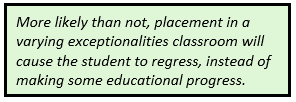
What program is most appropriate for
a preschooler with cochlear implants?
While this question needs to be answered on an individual basis, a 2004 court case provides important insights into what an appropriate program is – and is not.
The many factors that influence a child’s success with a cochlear implant include1:
|
|
|
Before a school can provide an appropriate educational program, it must be established the level to which the child has made auditory progress since the time of implantation. With appropriate early intervention, including work with the family and child to develop auditory skills, the following progress is expected2:
![]()
Lack of appropriate intervention, follow through by families, other health/development issues, and problems with equipment function will all slow down expected development. For a performance checklist for development of complex listening skills, see Activities for Listening and Learning.
In general, an educational environment that supports good use and continued auditory development using cochlear implants will have someone who knows how to support and maintain the CI, educators with a knowledge base about the impact of hearing loss on learning and how to best support performance, an optimal auditory environment via appropriate classroom acoustics and use of remote microphone technology (FM/DM system), and intervention to continue auditory development.
Relevant court case3: In 2004 the question about appropriate programming for preschoolers with cochlear implants was deliberated in Florida. The child received a cochlear implant at age 30 months and was receiving intensive services to promote listening and spoken language. At age 3 the family wanted the child to attend an auditory oral school for children who are deaf and hard of hearing so that rapid growth would continue in her listening and spoken language development. The school was offering placement in a varying exceptionalities (VE) class of students who are all developmentally delayed as there was no preschool class specially designed to teach children with hearing loss to listen and speak without using sign language. Neither the VE teacher nor the classroom aides had experience working with deaf children, nor did the available speech language pathologists. There was a special education teacher who had not worked with any oral deaf children. There was also an itinerant teacher of the deaf/hard of hearing who had some experience using sign language with students who had cochlear implants in secondary school grades, but no experience with a child who had a cochlear implant and required auditory skill development.
With close collaboration with the oral deaf school staff, an IEP was developed and the child began attending a pre-kindergarten VE class, even though she had no developmental delays unassociated with hearing loss. It was subsequently revealed that the child was receiving speech articulation services instead of intensive training to develop her ability to access and process sound through the auditory channel. The family rejected the placement and unilaterally returned the child to the oral deaf school.
 Findings: The district was found to have violated provide a free and appropriate public education (FAPE) as the IEPs developed by the school did not address the student’s need to learn how to hear, comprehend, and communicate in her mode of communication, thus not providing her with FAPE. The court found that the school’s proposed placement would not provide the student with FAPE because:
Findings: The district was found to have violated provide a free and appropriate public education (FAPE) as the IEPs developed by the school did not address the student’s need to learn how to hear, comprehend, and communicate in her mode of communication, thus not providing her with FAPE. The court found that the school’s proposed placement would not provide the student with FAPE because:
(1) a VE classroom is inappropriate because the student needs an educational program in a setting designed to allow meaningfully access to the educational process through an oral mode of communication,
(2) the district professionals lack the necessary knowledge, training, and experience to implement the IEP,
(3) the VE placement does not provide for necessary parent training, ongoing audiology support and hearing device troubleshooting services,
(4) the VE placement will not adequately develop the student’s auditory brain structure, and thus her ability to hear and speak, during the narrow window of opportunity before the student is 5-6 years of age,
(5) the VE placement fails to provide the student with the opportunity to achieve the goal of being mainstreamed by kindergarten or first grade.
Resources
- 1. Setting Appropriate Expectations and Communication Goals with a Cochlear Implant. https://advancedbionics.com/content/dam/advancedbionics/Documents/libraries/Tools-for-Schools/Educational_Support/presentations/Expectations_for_Cochlear_Implantation/ExpectationsforCochlearImplantation_Notes.pdf
- 2. Tools for Toddlers: TRACKING AUDITORY PROGRESS in children with cochlear implants. https://advancedbionics.com/content/dam/advancedbionics/Documents/libraries/Tools-for-Toddlers/early-intervention-professionals-teachers-therapists/Tracking-Auditory-Progress.pdf
- 3. N. vs St. Johns County School Board. https://successforkidswithhearingloss.com/wp-content/uploads/2019/10/Court-case-need-for-appropriate-preschool-program-for-child-with-CI.pdf

